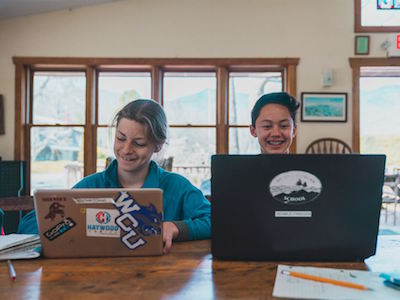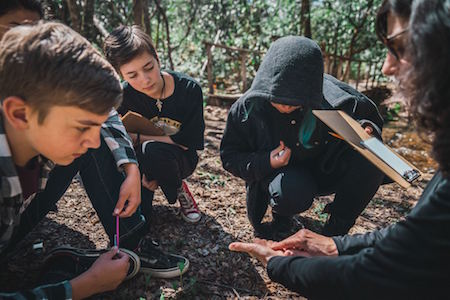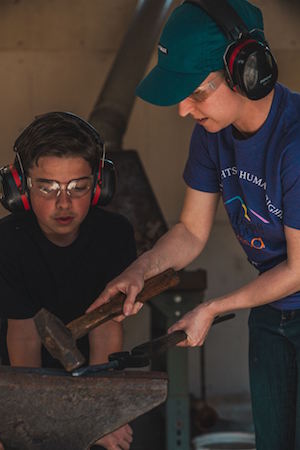How Much Screen Time is Healthy for a Teenager?

It’s a Tuesday afternoon and the students of Arthur Morgan School are having free time. They are skateboarding on the slab, working in the pottery studio, or playing board games in the meeting room. It’s a very different scene from many other middle schools today because one activity is missing: none of these teenagers are looking at screens.
One of the biggest concerns that parents of young adolescents have today is the question: How much screen time is healthy for a teenager? Smart phones, laptops, gaming devices all offer hours of distraction. Parents are worried that too much screen time will damage their teenager’s social skills or natural curiosity. Their fear is valid. Technology has many short term and long term effects emotionally, mentally and physically. Both the New York Times and The Guardian have featured articles about how both Silicon Valley employees and executives send their children to schools that limit or forbid technology use. If the people who create and best understand these systems are worried about them, then it makes sense that everybody else should be too.
To Ban or Not to Ban?
 At the same time parents want their teenagers to be technologically literate. As the world continues to rely on technology more and more, parents want their children to understand how to use technology effectively. High schools and colleges require students to know how to use word processing programs and do research on computers. They depend on students to be familiar with different apps and software programs. If a teenager enters high school without these skills, they can be at a real disadvantage.
At the same time parents want their teenagers to be technologically literate. As the world continues to rely on technology more and more, parents want their children to understand how to use technology effectively. High schools and colleges require students to know how to use word processing programs and do research on computers. They depend on students to be familiar with different apps and software programs. If a teenager enters high school without these skills, they can be at a real disadvantage.
Teenagers also need to practice navigating the dangers technology can pose. Avoiding malware, protecting themselves from identity theft and recognizing inappropriate social interactions are all important lessons young people should learn before living on their own.
Setting up Appropriate Technology Guidelines
 So what is a parent to do? How can they protect their teenagers from the numerous negative effects of technology while still adequately preparing their child for a world that depends so heavily upon it? At AMS, we bring our middle schoolers into the conversation. Instead of simply banning technology, we help them set up their own rules. We talk to them about the dangers technology poses. Then we work with them to set up appropriate guidelines that will adequately prepare them while still prioritizing being present to our community.
So what is a parent to do? How can they protect their teenagers from the numerous negative effects of technology while still adequately preparing their child for a world that depends so heavily upon it? At AMS, we bring our middle schoolers into the conversation. Instead of simply banning technology, we help them set up their own rules. We talk to them about the dangers technology poses. Then we work with them to set up appropriate guidelines that will adequately prepare them while still prioritizing being present to our community.
Thoughtful discussions with mentoring staff help students determine for themselves how much screen time is healthy for a teenager!
AMS middle schoolers don’t carry personal devices other than simple mp3 players. They don’t spend hours on social media or playing video games. Instead, they interact with one another. The school’s plethora of games, physical activity spaces, and art studios give students the opportunity to express themselves without needing to sit in front of computer. The 50+ acres of wilderness that surrounds the school allows them to explore the natural world. Students and staff play and work together to create a community that sees and hears one another. They experience and share their world directly instead of through a screen.
Responsible Use of Screen Time
The school does use computers. Students type papers for classes and do research on the internet. Teachers provide our middle schoolers with consistent guidance about how to understand the information they find. They encourage them think about the reliability and biases of different sources. As a result, the students get a better understanding of the many ways technology can be used positively or nefariously.
Then, once their work is done, the computer is shut down.  Occasionally students will watch a movie together or play music on the computer for impromptu dance parties. They also often play music while they work or do chores together. However, even these moments are given conscious thought.
Occasionally students will watch a movie together or play music on the computer for impromptu dance parties. They also often play music while they work or do chores together. However, even these moments are given conscious thought.
Once in an All School Meeting, students debated whether or not to use YouTube to play music. Although YouTube offered larger music selections than other applications, the students recognized the negative effect videos were having on the community. Instead of listening to the music in the background and still interacting with one another, the videos ended up captivating everyone’s attention. In response, the students chose to ban the use of YouTube for listening to music. The students’ decision demonstrates how they learn to see technology as a tool and use it only in ways that meet their needs: in the service of promoting community and positive connection.
Creating a Technology Safe Place
As technology continues to advance, parents’ concerns will also continue to grow. Virtual reality and artificial intelligence will make technology even more immersive and tempting to many young adolescents. Learning to use technology responsibly and consciously is a skill that will increasingly need practice. At AMS, we are giving our students these tools so they can interact with the world successfully while continuing to focus on the people around them.
-by Nicholas Maldonado
